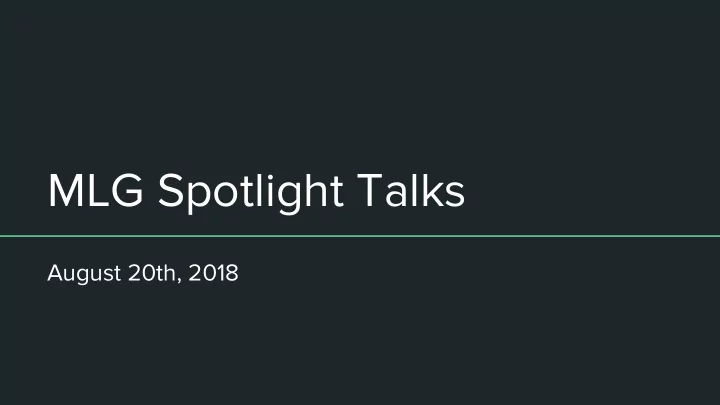

MLG Spotlight Talks August 20th, 2018
Growing Better Graphs with Latent-Variable Probabilistic Graph Xinyi Wang, Salvador Aguinaga, Tim Weninger, David Chiang Background and Problems Solution: latent variable HRG • Hyperedge Replacement Grammar (HRG) • Nonterminal Splitting [add CONTEXT to HRG] • Generate graphs like CFG generating strings • Learning with Expectation Maximization • Extract from the tree decomposition of a graph • Objective: max P(training graphs) • Rule splits to di ff erentiate contexts • Problem: Lack of context • Evaluation [robust and accurate] • Graph Generator • Log likelihood of TEST graph • Problem: Evaluate on training data Experiments and Results • Train/test graphs • Two synthesized graphs • Four real world graphs • Left: log likelihood is an e ff ective metric • Right: latent variable HRG improves over HRG • Comparable with other graph • On the test graph of similar structure with the • Log Likelihood always maximize at generators in terms of GCD training graph, the log likelihood is higher number of split n > 1 than the test graph of di ff erent structure
Watch Your Step: Learning Graph Embeddings through Attention Sami Abu-El-Haija 1,2 , Bryan Perozzi 2 , Rami Al-Rfou 2 , Alex Alemi 2 1 2 Task: Node Embeddings E[statistics] t-SNE: node2vec [3] VS ours - Goal: Learn Node Embeddings. We derive analytical solution on Useful for various tasks (Link (anchor, context) sampling: Prediction & Node Classification) - modern methods pass random walk sequences to word2vec [1], which samples context using Learned Ours: uniform distribution: We train the context distribution Q : differs jointly with embeddings: per net Results: reduce errors (link Our Objective: extends [2] prediction by 20%-40%; Node classification by up to 10%) [1] Perozzi et al, DeepWalk , KDD’14 [2] Abu-El-Haija et al, AsymProj , CIKM’17 [3] Grover & Leskovec, node2vec , KDD’15 * work was done while Sami was Google AI (formally, Google Research)
t-PINE: Tensor-based Predictable and Interpretable Node Embeddings Saba Al-Sayouri, Ekta Gujral, Danai Koutra, Evangelos E. Papalexakis, and Sarah S. Lam Baselines Present Gap t-PINE Better performance Unsatisfactory Tensor Representation Accuracy (Multi-view accuracy formation Learning information graph) Explicit Explicit & Implicit representation Shallow models representation learning learning Joint explicit & Disjoint explicit implicit & implicit Representations representation representation concatenation learning (CP learning decomposition) Uninterpretable Interpretability Interpretable SIGKDD MLG Workshop 2018 – London, United Kingdom, August 2018
Can exploiting links in relational data lead to greater accuracy in predicting elections as they unfold in real-time? How to “bootstrap” initial predictions How to compute links so as to connect How can we perform effective to provide a baseline for inference? the regions into a useful graph? collective inference? • • • Combine vote and region features Leverage region-to-region correlations Executes over 100x faster!
Reducing Network Incompleteness Through Online Learning Timothy LaRock * Timothy Sakharov * Sahely Bhadra † Tina Eliassi-Rad * * Northeastern University † IIT Palakkad • Network data is often incomplete Potential DBLP DBLP • Acquiring more data can be High Modularity for Cora Cora expensive and/or hard learning CAIDA CAIDA Learning BTER • Research question: not useful Enron Enron LFR • Given a network and limited Low Modularity Heuristic ER resources to collect more data, BA optimal how can we get the most bang for our buck? Homogeneous Degree Heterogeneous Degree Supported by NSF 1314603
What the HAK ? Estimating Ranking Deviations in Incomplete Graphs Helge H olzmann, Avishek A nand, Megha K hosla ● Graphs collected on the Web are typically incomplete ● Hypothesis: Incomplete graphs (e.g., crawls, Web archives, ...) cause deviations in random walk algorithms, such as PageRank ● Consequence: Rankings corresponding to PageRank differ from the (unavailable) complete / original graph ● RQ I : Do incomplete real-world graphs show a deviation in their PageRank ? ● RQ II : How can we reliably measure the extent of such ranking deviations for incomplete graphs?
Hierarchical Graph Clustering by Node Pair Sampling Thomas Bonald, Bertrand Charpentier, Alexis Galland, Alexandre Hollocou I Most real graphs have a multi-scale structure I We propose a novel hierarchical graph clustering algorithm I The algorithm is agglomerative , with a distance between clusters induced by node pair sampling
Generalized Embedding Model for Knowledge Graph Mining � Contribution � Task - Learning reasonable and accurate distributed a) Propose GEN, an efficient embedding learning representations for knowledge graph. framework for generalized KGs - Flexible enough to adapt to variations networks b) Consider “multi - shot” information for embedding learning simultaneously • (Subject, Predicate) ⇒ Object • (Object, Predicate) ⇒ Subject • (Subject, Object) ⇒ Predicate c) We show that GEN can works on graphs in different domains MLG 2018 London, United Kingdom Rui Wan rwan@std.uestc.edu.cn
Network Signatures from Image Representation of Adjacency Matrices: Deep/Transfer Learning for Subgraph Classification Kshiteesh Hegde, Malik Magdon-Ismail, Ram Ramanathan and Bishal Thapa Accuracy: 86%
Recommend
More recommend